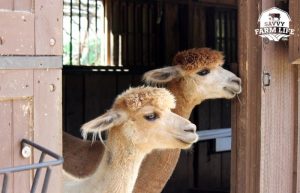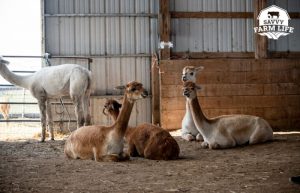
What You Need to Know About Alpaca Shelters
You may be researching alpacas as you consider whether they are right for you. As I’ve raised livestock animals, I’ve learned that some are more susceptible to the elements than others. That being said, it’s essential to know how the weather will affect your alpacas and what you can do to help them stay comfortable.
Do alpacas need shelter? While alpacas are hardy animals, they will require a safe and dry shelter to escape the elements and the heat. With thick coats of wool, a shelter that provides shade can help them escape the heat of the day. A shelter that keeps them dry can help prevent hypothermia and skin conditions like rain scald.
Alpacas are versatile animals that can live in a variety of climates. The climate will play a significant role in determining the necessities of an alpaca shelter. To learn more, read on!
The Alpaca’s Natural Habitat
Before exploring the alpaca’s shelter requirements, let’s first talk about how adaptable they are to different climates. Alpacas originated in Peru – specifically the high mountain ranges in Peru. They are accustomed to both the warm, humid weather found in the country and the frost and wind that comes from living in the mountains. While alpacas are highly adaptable to different environments and weather, like other animals that carry fleece, extreme heat will usually concern the alpaca more than cold and snow.
Cold Weather Alpaca Shelters
Alpacas are cold-hardy and can thrive in temperatures as low as 15 degrees Fahrenheit. Of even more concern than the temperature, however, is the wind chill. Alpacas will need a shelter to protect them from the cold wind and extreme weather, especially crias (baby alpacas) and dams (alpaca mothers).
What Type of Shelter do You Need for Alpacas in Cold Weather?
Before you start researching the cost of erecting a full-sized barn, however, know that because alpacas are cold-hardy, they are likely to need no more than a simple three-sided shelter. These can be built and maintained easily – just three walls and a roof. Be sure to make the three-sided shelter so that it is not facing the wind. This type of shelter should provide adequate protection for your alpaca herd in the cold winter if you keep this in mind. The shelter can act as a windbreak to protect your alpacas from the wind.
To get a complete overview on how to care for your alpacas, visit my article Are Alpacas Hard to Care For? Alpaca Care Essential Guide.
Additional Precautions to Take in A Cold Weather Shelter
When designing this three-sided shelter, make sure that you take into account the footing. Alpacas have a warm, thick fleece that keeps them warm in the cold seasons, but their feet can get cold. You can solve this problem by placing straw or rubber mats in the shelter to give their cold feet a reprieve. Alpacas keep a communal bathroom, preferring to eliminate waste in the same 2-3 “piles” each time, making it easier to keep the straw or other bedding clean.
Make sure to provide additional hay to alpacas during the winter months so that they can keep their body fat at an appropriate level to keep them warm. One other note – if you are expecting to raise crias (baby alpacas), make sure to time the breeding so that they are born in the Spring months, giving them ample time to grow a protective fleece by the cold season.
Hot Weather Alpaca Shelters
While alpacas are hardy to cold weather, they are more sensitive to the heat. Heat stress is a legitimate concern for alpacas, and a proper shade structure is essential if you are in an environment that experiences hot Summers.
Calculating Heat Index and How it Affects Your Alpacas
One way to measure how the heat will affect your alpaca is by measuring the heat index. This calculation adds the temperature (Fahrenheit) and the humidity percentage. For example, if the temperature high for the day is estimated to be 100 degrees with 40% humidity, the heat index will be 140. If the temperature is 105 degrees with 20% humidity, the heat index will be 125.
As a rule of thumb, if the heat index is below 120, there is little cause for concern to your alpacas. If the heat index is between 120 and 159, precautions should ensure that your alpacas do not overheat. Heat stress is likely for a heat index between 160 and 179, and precautions must be taken to limit the strain on your alpacas. Anything over 180 is a high risk, and your alpacas should be checked on throughout the day.
What Type of Shelter Do Alpacas Need in Hot Weather?
 The type of shelter for an alpaca in hot weather will be the same as the shelter recommended for cold weather – a 3-sided covered shelter is sufficient. The only difference is what can be added to this shelter to keep it cool and offer a refreshing break for your alpacas during the hottest part of the day. Many alpaca keepers place fans in the shelters to circulate the air. This can be done easily with a box fan and an extension cord, so long as you keep the fans high enough to prevent the alpacas from injuring themselves with the fan blades. I like to hang my box fans from the rafters of the barn to provide a circulating breeze. Many keepers in hot climates also utilize sprinklers to keep the shelter and surrounding areas cool for the alpacas. Misting kits are another easy way to lower the temperature – a portable misting kit purchased from a hardware store can reduce the air temperature by as much as 20 degrees and is simple to set up with a regular garden hose.
The type of shelter for an alpaca in hot weather will be the same as the shelter recommended for cold weather – a 3-sided covered shelter is sufficient. The only difference is what can be added to this shelter to keep it cool and offer a refreshing break for your alpacas during the hottest part of the day. Many alpaca keepers place fans in the shelters to circulate the air. This can be done easily with a box fan and an extension cord, so long as you keep the fans high enough to prevent the alpacas from injuring themselves with the fan blades. I like to hang my box fans from the rafters of the barn to provide a circulating breeze. Many keepers in hot climates also utilize sprinklers to keep the shelter and surrounding areas cool for the alpacas. Misting kits are another easy way to lower the temperature – a portable misting kit purchased from a hardware store can reduce the air temperature by as much as 20 degrees and is simple to set up with a regular garden hose.
The affect that weather has on alpacas is quite similar to the affect it has on sheep. Since sheep and alpacas can both have a thick wool fleece, they tend to be hardier in colder climates compared to other livestock animals. To learn how weather can affect sheep, check out my article Leaving Sheep Out in the Rain: Everything You Need to Know.
Additional Precautions to Take in Hot Weather
How else can you help your alpacas remain cool in a hot climate? It is imperative that you shear your alpacas before the heat of Summer – leaving their full fleece on them will overheat them quickly. It is a good rule of thumb to shear alpacas during the Spring months. Make sure to leave a short amount of fleece to prevent sunburn. It is also crucial that you know that pregnant dams create excessive amounts of heat and will require additional care to ensure heat stress does not affect them; otherwise, it will threaten the crias. Try to avoid having a heavily pregnant dam in the hottest months. And of course – make sure there is plenty of cool water available at all times. Adding frozen water bottles to the water can help keep it cool longer, especially in the shade.
Alpaca Shelter – Mild Weather
Are you fortunate enough to live in an area that is neither excessively cold nor hot? You can erect a 3-sided shelter, but you also may be able to get away with using a shaded tree or other simple structure instead. Alpacas, like all livestock, would much rather be outside in the elements than indoors, even if the weather is briskly cool or sunny and warm. Not only is this the typical preference, but it is also healthy for them to be outside as much as possible, breathing the fresh air.
A Note About Rain and How it Affects Alpacas
Even if you live in a mild climate, ensure there is adequate cover for your alpacas should it rain. Alpacas do not like the rain and usually will not graze in it either, preferring to take shelter and wait out the weather before venturing out again to eat. If it rains for an extended period, you may wish to provide hay in whatever adequate shelter they have so that they can continue to eat throughout the day. Maintaining proper fat proportions is crucial to the alpaca’s system of temperature regulation.
Even in mild temperatures, excessive amounts of moisture can lead to hypothermia if the moisture can get through the wool fleece of the alpaca. Once rain or water has soaked through the alpaca’s wool, it can be difficult for the alpaca to dry off. The wool will hold moisture to the skin, which will cause irritation and even hypothermia. For this reason, it’s essential to have a shelter that will stay dry even in bad weather.
Can All Your Alpacas Fit in the Shelter?
Regardless of your region, you also need to know how large to make your shelter. Alpacas are social creatures and live in herds. The herd is vital to the individuals, and they do not like to be alone. Make sure that whatever shelter you create, build, or fashion, you provide enough room for everyone. They will seek shelter together and will be more comfortable in the midst of one another.
Alternatives to a 3-Sided Shelter
While the 3-sided open shelter is adequate for most climates, you may already have a barn on-site, and you may wish to use that instead. Or, perhaps you are worried about predators and would like to lock up your alpacas at night. You can use a barn or other enclosed space for your alpacas, provided you clean them out regularly and they have adequate ventilation to ensure good respiratory health. If you can see condensation anywhere in the space, that means it is not adequately ventilated.
If using a barn or other enclosed space, ensure you have adequate footing. Concrete floors and wood floors are not recommended for alpacas. Rubber mats, straw, shavings, and regular dirt floors are all appropriate materials to use. If you choose to use wood shavings, be aware that they will stick to the alpaca’s fleece and will be difficult to brush out.
Choosing An Appropriate Alpaca Shelter
Proper shelters are dependent upon your circumstances and the climate in which you reside. Regardless of your region, the most important considerations to take into account are locating your shelter appropriately according to the wind direction, using additional measures in the shelter to protect against extreme weather (such as bedding for cold weather, fans, and misters for hot weather), and maintaining adequate ventilation.
Alpacas are unique and interesting animals related closely to llamas. Llamas are often most known for their spitting abilities. That being said, do alpacas spit? You can get your answer by visiting my article Do Alpacas Spit? Everything You Need to Know.
